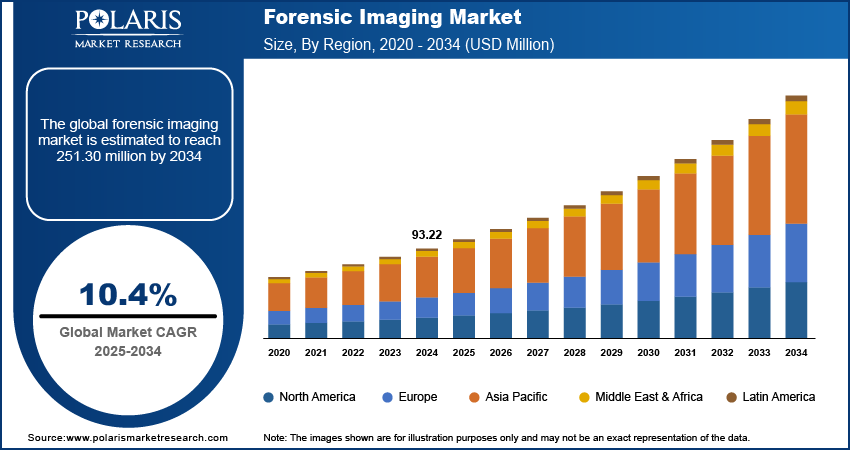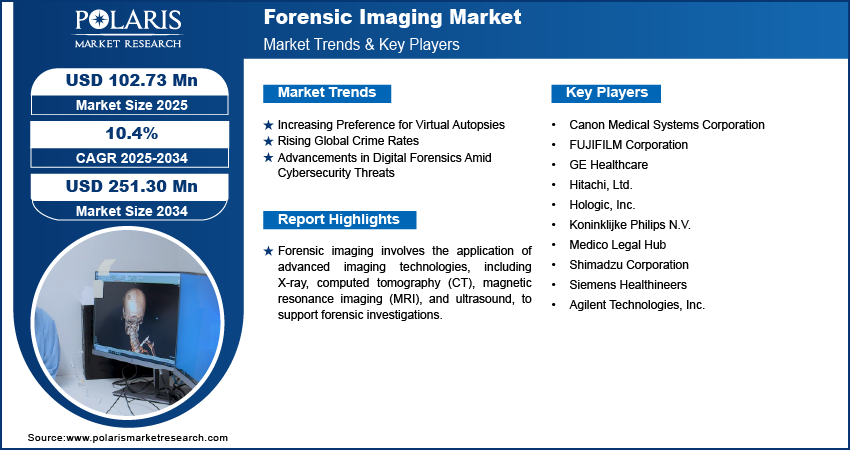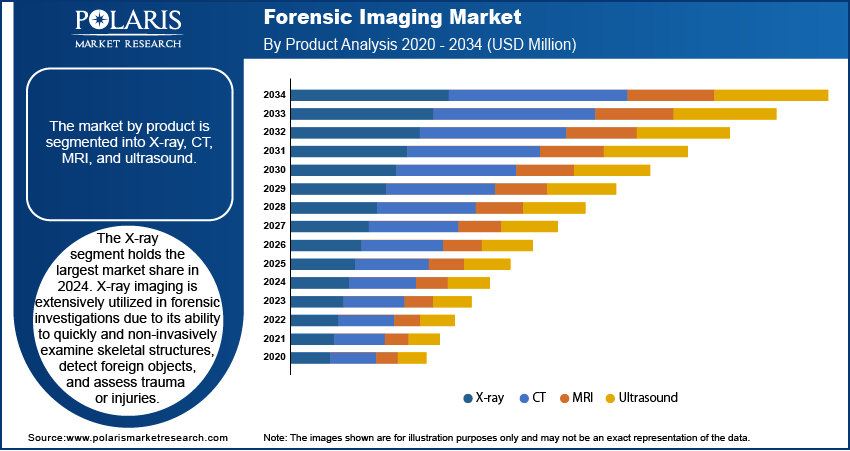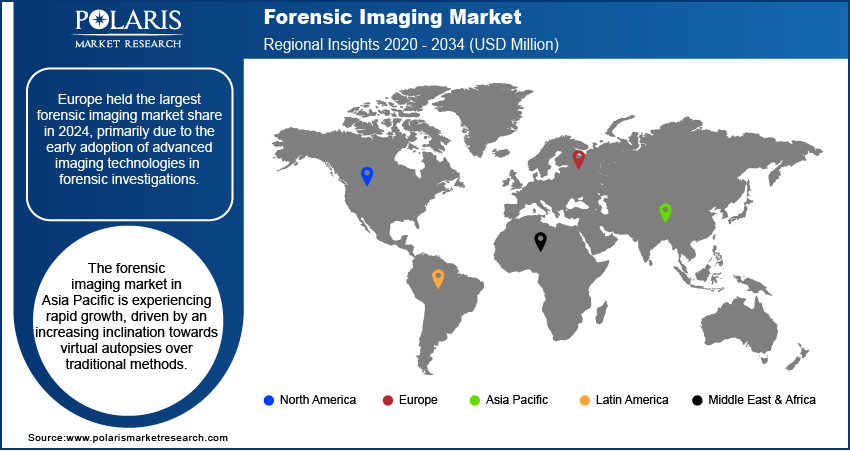
Forensic Imaging Market Size, Share, Trends, Industry Analysis Report
: By Product (X-Ray, CT, MRI, and Ultrasound), Application, End Use, and Region (North America, Europe, Asia Pacific, Latin America, and Middle East & Africa) – Market Forecast, 2025–2034
- Published Date:Apr-2025
- Pages: 116
- Format: PDF
- Report ID: PM1793
- Base Year: 2024
- Historical Data: 2020-2023
Forensic Imaging Market Overview
The forensic imaging market size was valued at USD 93.22 million in 2024. The market is projected to grow from USD 102.73 million in 2025 to USD 251.30 million by 2034, exhibiting a CAGR of 10.4% during 2025–2034.
Forensic imaging involves creating precise replicas of digital storage media, such as hard drives or flash drives, to preserve their contents for analysis in criminal investigations. This process captures all data, including deleted files and unallocated space, without altering the original evidence, thereby maintaining data integrity and allowing investigators to analyze the copied information while safeguarding the original device from potential changes or damage.
The global forensic imaging market is experiencing significant growth, driven by several key factors. The increasing preference for virtual autopsies over traditional methods has boosted market expansion. Virtual autopsies, which utilize advanced imaging technologies such as computed tomography (CT) and magnetic resonance imaging (MRI), offer a minimally invasive alternative that provides detailed insights without the need for conventional procedures. Additionally, the rising global crime rate has heightened the demand for accurate and reliable forensic imaging solutions to support law enforcement and judicial processes. Technological advancements, including the integration of artificial intelligence and machine learning, have further enhanced the capabilities of forensic imaging, enabling more precise and efficient analyses. These developments, coupled with increased government funding for forensic research and the expansion of forensic laboratories globally, are propelling the growth of the market.

To Understand More About this Research: Request a Free Sample Report
Forensic Imaging Market Dynamics
Increasing Preference for Virtual Autopsies
The shift towards virtual autopsies, also known as "virtopsy," has become a significant forensic imaging market driver. Utilizing advanced radiological techniques such as computed tomography (CT) and magnetic resonance imaging (MRI), virtual autopsies provide detailed internal examinations of deceased individuals without the need for invasive procedures. This approach is particularly advantageous in cases where traditional autopsies are culturally sensitive or when there's a risk of infection. The minimally invasive nature of virtual autopsies has led to their increased adoption in forensic investigations, offering specific, sensitive, and accurate insights that are sometimes superior to conventional methods. Furthermore, the digitalization of evidence through imaging technologies facilitates data storage and reduces the risk of tampering, enhancing the integrity of forensic investigations.
Rising Global Crime Rates
The escalation of crime rates worldwide has intensified the demand for advanced forensic imaging technologies. Law enforcement agencies are increasingly relying on advanced imaging tools to thoroughly investigate crime scenes and provide compelling evidence in court proceedings. In Europe, intentional killings rose by 3.5% in 2020, according to Eurostat data. These alarming statistics underscore the necessity for precise and reliable forensic imaging solutions to support law enforcement efforts and enhance the accuracy of criminal investigations.
Advancements in Digital Forensics Amid Cybersecurity Threats
The surge in cybercrime, including data breaches, ransomware attacks, and identity theft, has propelled the need for advanced digital forensic imaging solutions. As organizations and individuals increasingly rely on digital infrastructures, the potential for cyberattacks has grown exponentially. Check Point Research reported a 38% increase in global cyberattacks in 2022 compared to the previous year, with attacks occurring approximately every 39 seconds. These trends have necessitated the adoption of robust digital forensic tools capable of identifying perpetrators, mitigating risks, and ensuring regulatory compliance, thereby driving forensic imaging market growth.

Forensic Imaging Market Segment Insights
Forensic Imaging Market Assessment by Product
The forensic imaging market is segmented by product into X-ray, CT, MRI, and ultrasound. The CT segment held the largest forensic imaging market share in 2024. CT imaging offers detailed cross-sectional views of the body, enabling comprehensive analysis of internal injuries, pathologies, and foreign objects without invasive procedures. This modality's ability to reconstruct three-dimensional images provides forensic experts with precise anatomical information, enhancing the accuracy of investigations. The increasing adoption of CT imaging in forensic applications is driven by its superior diagnostic capabilities and the growing recognition of its value in legal proceedings, contributing to its rapid market growth.
Forensic Imaging Market Evaluation by Application
The forensic imaging market segmentation, based on application, includes death investigations and clinical studies. The death investigations segment holds the largest market share. This prominence is driven by the increasing incidence of unnatural deaths, including homicides, suicides, and accidental traumas, necessitating thorough post-mortem analyses. Forensic imaging technologies, such as X-ray and computed tomography (CT), are extensively utilized to conduct non-invasive autopsies, providing detailed internal visualizations that aid in determining the cause of death. The adoption of virtual autopsy methods has gained traction due to their ability to preserve the integrity of remains, which is particularly important in cases involving cultural or religious sensitivities. Moreover, judicial systems are increasingly relying on forensic imaging to provide compelling evidence in court proceedings, especially in scenarios lacking eyewitness accounts. These factors collectively contribute to the dominance of the death investigations segment.
The clinical studies segment is experiencing the highest forensic imaging market CAGR. This surge is attributed to the expanding utilization of imaging technologies in anatomical research and the study of disease pathophysiology. The increasing number of individuals voluntarily donating their bodies for scientific research has amplified the demand for advanced imaging modalities to conduct detailed anatomical studies. Additionally, the emergence of new and deadly diseases has underscored the need for comprehensive studies to understand disease mechanisms, where forensic imaging plays a pivotal role.
Forensic Imaging Market Outlook by End Use
The forensic imaging market segmentation, based on end use, includes forensic institutes, hospitals, and others. The forensic institutes held the largest market share in 2024. These specialized institutions are dedicated to the application of scientific methods for crime investigation and evidence analysis, fostering expertise in advanced imaging technologies. Their comprehensive approach integrates multidisciplinary teams, including forensic scientists, pathologists, and imaging specialists, who collaborate to deliver precise analyses crucial for criminal investigations. The installation of imaging equipment in forensic institutions has increased as a result of increased research into the evaluation and effects of the use of contemporary imaging technologies in forensic medicine.
The hospital segment is experiencing the highest forensic imaging market growth. Hospitals possess the necessary infrastructure, including floor space, technical staff, and medical professionals, to perform virtual autopsies efficiently. Conducting forensic imaging within hospital settings mitigates the costs, risks, and time associated with transferring bodies to external forensic institutes for examination. Additionally, the integration of forensic imaging in hospitals enhances the collaboration between medical and forensic experts, facilitating comprehensive analyses that benefit both clinical and legal outcomes.

Forensic Imaging Market Regional Analysis
By region, the study provides forensic imaging market insights into North America, Europe, Asia Pacific, Latin America, and the Middle East & Africa. Europe held the largest market share in 2024, primarily due to the early adoption of advanced imaging technologies in forensic investigations. Countries such as the UK, Germany, and France have been instrumental in integrating advanced imaging solutions into their forensic practices, supported by substantial investments in digital forensic capabilities and infrastructure enhancement. Strong regulatory frameworks and collaborative efforts among European nations further boost the market dominance, ensuring standardized and efficient crime investigation processes. Additionally, the emphasis on high-quality forensic procedures and government initiatives aimed at improving forensic science training contributes significantly to the forensic imaging market growth in Europe.
The forensic imaging market in Asia Pacific is experiencing rapid growth, driven by an increasing inclination towards virtual autopsies over traditional methods. The availability of advanced imaging equipment, coupled with enhancements in healthcare infrastructure, facilitates the adoption of non-invasive forensic procedures. Government initiatives aimed at upgrading forensic infrastructure and technology, along with rising public awareness regarding the importance of forensic science in criminal investigations, are critical drivers of this growth. Notably, India is expected to register the highest growth rate in the coming years, reflecting the region's expanding commitment to integrating advanced forensic imaging solutions.

Forensic Imaging Market – Key Players and Competitive Insights
The competitive landscape of the forensic imaging market features global and regional players competing through innovation and strategic alliances. Global players leverage R&D capabilities and technological advancements to deliver advanced solutions, meeting the demand for disruptive technologies. Market trends highlight rising technological adoption driven by economic growth and geopolitical shifts. Companies focus on strategic investments, mergers, and joint ventures to strengthen market positions. Regional players offer cost-effective solutions tailored to local needs. The market experiences ongoing technological transformation, with companies investing in supply chain management and sustainability strategies.
Competitive intelligence and pricing insights are critical for identifying growth opportunities. The industry's growth is driven by technological innovation, market adaptability, and strategic regional investments, ensuring sustained competitiveness in a dynamic global market. A few major players are Canon Medical Systems Corporation, FUJIFILM Corporation, GE Healthcare, Hitachi, Ltd., Hologic, Inc., Koninklijke Philips N.V., Medico Legal Hub, Shimadzu Corporation, Siemens Healthineers, and Agilent Technologies, Inc.
Canon Medical Systems Corporation, headquartered in Ōtawara, Tochigi, Japan, specializes in medical imaging and diagnostic solutions. Originally established as Toshiba Medical Systems, the company pioneered X-ray tube research in 1914 and introduced Japan's first MRI systems in 1983. Acquired by Canon Inc. in 2016, it now operates as a subsidiary under Canon's umbrella. The corporation offers a wide range of advanced medical imaging technologies, such as CT, MRI, ultrasound, X-ray systems, and nuclear medicine systems. With a philosophy of "Made for Life," Canon Medical Systems emphasizes patient-centric innovations aimed at improving healthcare outcomes. In forensic imaging, Canon Medical Systems provides cutting-edge solutions that assist in non-invasive post-mortem examinations and forensic investigations. Technologies such as high-resolution CT scanners and advanced visualization software enable detailed analysis of injuries and pathological findings without the need for traditional autopsies. These tools are particularly valuable in legal and investigative contexts where precision and documentation are critical.
GE Healthcare is a medical technology, pharmaceutical diagnostics, and digital solutions company committed to improving healthcare delivery across the patient journey. The company specializes in imaging technologies like magnetic resonance imaging (MRI), computed tomography (CT), and molecular imaging, alongside ultrasound and patient care solutions such as remote monitoring and anesthesia systems with over 100 years of innovation. It also manufactures pharmaceutical diagnostics, such as contrast agents and radiopharmaceuticals. The company serves over one billion patients annually and boasts an installed base of more than four million devices globally. In forensic imaging, GE Healthcare’s advanced imaging technologies play a crucial role in non-invasive investigations, enabling detailed analysis of soft tissues and injuries for legal and medical purposes.
List of Key Companies in Forensic Imaging Market
- Canon Medical Systems Corporation
- FUJIFILM Corporation
- GE Healthcare
- Hitachi, Ltd.
- Hologic, Inc.
- Koninklijke Philips N.V.
- Medico Legal Hub
- Shimadzu Corporation
- Siemens Healthineers
- Agilent Technologies, Inc.
Forensic Imaging Market Developments
- April 2024: Shimadzu Corporation acquired California X-ray Imaging Services, Inc. (CIS) to strengthen its direct sales and service capabilities for medical systems on the U.S. West Coast. This strategic move aims to enhance customer relationships and improve profitability in the region.
- January 2024: Canon Medical Systems Corporation and Olympus Corporation entered into a business alliance to collaborate on the development and marketing of endoscopic ultrasound systems. Canon Medical will develop and manufacture diagnostic ultrasound systems for endoscopic ultrasonography (EUS), while Olympus will handle sales and marketing efforts. The collaboration aims to provide advanced EUS equipment capable of delivering high-quality imaging for early disease detection.
Forensic Imaging Market Segmentation
By Product Outlook (Revenue-USD Million, 2020–2034)
- X-Ray
- CT
- MRI
- Ultrasound
By Application Outlook (Revenue-USD Million, 2020–2034)
- Death Investigations
- Clinical Studies
By End Use Outlook (Revenue-USD Million, 2020–2034)
- Forensic Institutes
- Hospitals
- Others
By Regional Outlook (Revenue-USD Million, 2020–2034)
- North America
- US
- Canada
- Europe
- Germany
- France
- UK
- Italy
- Spain
- Netherlands
- Russia
- Rest of Europe
- Asia Pacific
- China
- Japan
- India
- Malaysia
- Suth Korea
- Indnesia
- Australia
- Vietnam
- Rest of Asia Pacific
- Middle East & Africa
- Saudi Arabia
- UAE
- Israel
- Suth Africa
- Rest of Middle East & Africa
- Latin America
- Mexic
- Brazil
- Argentina
- Rest of Latin America
Forensic Imaging Market Report Scope
|
Report Attributes |
Details |
|
Market Size Value in 2024 |
USD 93.22 million |
|
Market Size Value in 2025 |
USD 102.73 million |
|
Revenue Forecast by 2034 |
USD 251.30 million |
|
CAGR |
10.4% from 2025 to 2034 |
|
Base Year |
2024 |
|
Historical Data |
2020–2023 |
|
Forecast Period |
2025–2034 |
|
Quantitative Units |
Revenue in USD million and CAGR from 2025 to 2034 |
|
Report Coverage |
Revenue Forecast, Market Competitive Landscape, Growth Factors, and Industry Trends |
|
Segments Covered |
|
|
Regional Scope |
|
|
Competitive Landscape |
|
|
Report Format |
|
|
Customization |
Report customization as per your requirements with respect to countries, regions, and segmentation. |
How is Report Valuable for Organization?
Workflow/Innovation Strategy
The forensic imaging market has been segmented into detailed segments of product, application, and end use. Moreover, the study provides the reader with a detailed understanding of the different segments at both the global and regional levels.
Growth/Marketing Strategy
Companies in the forensic imaging market focus on growth and marketing strategies that emphasize technological advancements, strategic partnerships, and geographic expansion. Investments in research and development drive innovations in imaging modalities, such as high-resolution CT and MRI, to improve forensic investigations. Collaborations with forensic institutes, hospitals, and law enforcement agencies help expand market reach and enhance product adoption. Companies also engage in training programs and educational initiatives to increase awareness about the benefits of forensic imaging. Additionally, digital marketing and participation in industry conferences contribute to brand visibility and customer engagement.
FAQ's
The forensic imaging market size was valued at USD 93.22 million in 2024 and is projected to grow to USD 251.30 million by 2034.
The market is projected to register a CAGR of 10.4% during the forecast period, 2025-2034.
Europe had the largest share of the market in 2024.
Prominent among these are Canon Medical Systems Corporation, FUJIFILM Corporation, GE Healthcare, Hitachi, Ltd., Hologic, Inc., Koninklijke Philips N.V., Medico Legal Hub, Shimadzu Corporation, Siemens Healthineers, and Agilent Technologies, Inc.
The CT segment accounted for the largest market share in 2024.
Forensic imaging refers to the use of advanced imaging technologies, such as X-ray, computed tomography (CT), magnetic resonance imaging (MRI), and ultrasound, to assist in forensic investigations and legal proceedings. It enables non-invasive examination of human remains, crime scene evidence, and biological samples to determine causes of death, identify injuries, and analyze forensic evidence. This technology is widely used in post-mortem examinations, virtual autopsies, and clinical forensic studies, aiding forensic pathologists, law enforcement agencies, and medical professionals in criminal investigations and legal cases.
